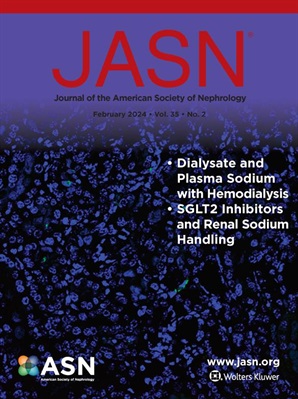Structured Application of Genetic Testing in a Pediatric Kidney Clinic.
IF 9.4
1区 医学
Q1 UROLOGY & NEPHROLOGY
引用次数: 0
Abstract
BACKGROUND The expanding knowledge of identifiable genetic contributions to pediatric inherited kidney diseases and the increasing availability of genetic testing resources necessitate a combined nephrogenetics clinical approach. While such models are described for adults, the impact of a structured nephrogenetics workflow on children with inherited kidney disease has not been rigorously evaluated. METHODS Clinical and genetic data of patients aged <1 - 21 years a 10-year period between 2014-2024 from a single-center pediatric inherited kidney disease outpatient program was evaluated. Genetic variants were classified as pathogenic/likely pathogenic and variants of uncertain significance (VUS). Patients were grouped into 'informative' or 'uninformative' groups based on the impact of genetic test results on disease management and outcomes. RESULTS Of the N=356 patients evaluated for a known or suspected inherited kidney disease, N=188 received clinical genetic testing. Of these, N=147 had an 'informative' genetic test affecting at least one positive clinical outcome. Patients with an 'informative' genetic test mostly harbored a pathogenic/likely pathogenic variant (N=122). An additional N=25 had a VUS re-classified as a 'VUS-of-interest' affecting a positive outcome measure. Genetic test results led to change in clinical diagnosis (reverse phenotyping, 46%), informed specific diagnosis-based treatment (46%), avoided unnecessary immunosuppression (27%) or kidney biopsy (18%) and guided extrarenal evaluation (72%) in patients with an informative test. Patients with a glomerular (OR=5.23, 95% confidence interval (CI) 1.96-13.96 ) or a tubular functional disease (OR=2.17, 95% CI 1.31-5.59) were more likely and those with a structural kidney disease (OR=0.39, 95% CI 0.25-0.60 ) were less likely to receive a genetic test when compared to all other disease categories combined. CONCLUSIONS This workflow integrated multidisciplinary care for children with inherited kidney disease and describes a model for actionable clinical care plans after genetic testing. Informative genetic tests were associated with positive outcomes and notable challenges include access to combined nephrology and genetics expertise for informed testing and an effective result return including VUS interpretation.基因检测在儿科肾脏诊所的结构化应用。
背景:对儿童遗传性肾脏疾病的可识别基因贡献的知识不断扩大,以及基因检测资源的日益可用性,需要一种联合肾遗传学临床方法。虽然这些模型是为成人描述的,但结构化肾脏遗传学工作流程对患有遗传性肾病的儿童的影响尚未得到严格评估。方法对单中心儿童遗传性肾病门诊项目2014-2024年10年间年龄<1 - 21岁患者的临床和遗传数据进行评估。遗传变异分为致病性/可能致病性和不确定意义变异(VUS)。根据基因检测结果对疾病管理和结果的影响,将患者分为“信息丰富”组和“信息贫乏”组。结果在356例已知或疑似遗传性肾病患者中,188例接受了临床基因检测。其中,N=147例具有“信息性”基因检测,至少影响一项阳性临床结果。具有“信息性”基因检测的患者大多携带致病/可能致病变异(N=122)。另有N=25的VUS被重新分类为“感兴趣的VUS”,影响了积极的结果测量。基因检测结果导致临床诊断的改变(反向表型,46%),为特定的基于诊断的治疗提供信息(46%),避免不必要的免疫抑制(27%)或肾活检(18%),并在信息检测患者中指导肾外评估(72%)。肾小球(OR=5.23, 95%可信区间(CI) 1.96-13.96)或肾小管功能性疾病(OR=2.17, 95% CI 1.31-5.59)患者接受基因检测的可能性更高,而结构性肾脏疾病(OR=0.39, 95% CI 0.25-0.60)患者接受基因检测的可能性较低。结论:该工作流程整合了遗传性肾病儿童的多学科护理,并描述了基因检测后可操作的临床护理计划模型。信息性基因检测与阳性结果相关,值得注意的挑战包括获得肾脏病学和遗传学联合专业知识以进行知情检测和有效的结果返回,包括VUS解释。
本文章由计算机程序翻译,如有差异,请以英文原文为准。
求助全文
约1分钟内获得全文
求助全文
来源期刊
CiteScore
22.40
自引率
2.90%
发文量
492
审稿时长
3-8 weeks
期刊介绍:
The Journal of the American Society of Nephrology (JASN) stands as the preeminent kidney journal globally, offering an exceptional synthesis of cutting-edge basic research, clinical epidemiology, meta-analysis, and relevant editorial content. Representing a comprehensive resource, JASN encompasses clinical research, editorials distilling key findings, perspectives, and timely reviews.
Editorials are skillfully crafted to elucidate the essential insights of the parent article, while JASN actively encourages the submission of Letters to the Editor discussing recently published articles. The reviews featured in JASN are consistently erudite and comprehensive, providing thorough coverage of respective fields. Since its inception in July 1990, JASN has been a monthly publication.
JASN publishes original research reports and editorial content across a spectrum of basic and clinical science relevant to the broad discipline of nephrology. Topics covered include renal cell biology, developmental biology of the kidney, genetics of kidney disease, cell and transport physiology, hemodynamics and vascular regulation, mechanisms of blood pressure regulation, renal immunology, kidney pathology, pathophysiology of kidney diseases, nephrolithiasis, clinical nephrology (including dialysis and transplantation), and hypertension. Furthermore, articles addressing healthcare policy and care delivery issues relevant to nephrology are warmly welcomed.

 求助内容:
求助内容: 应助结果提醒方式:
应助结果提醒方式:


